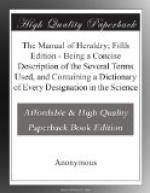Supporters were not introduced in English heraldry previous to the reign of Richard II. The shield of this luxurious monarch is supported on each side by an angel habited, and beneath the shield by a white hart couchant, gorged and chained or, beneath a tree. The shield of Henry IV., the founder of the Lancastrian dynasty, was supported on the dexter side by a swan, on the sinister side by an antelope, both gorged and lined or. The shield of the gallant Henry V. was supported on the dexter side by a lion rampant guardant, crowned or; on the sinister side by an antelope, gorged and chained. Henry VI. had two antelopes as supporters to his achievement. The shield of the gallant Yorkist Edward IV. is supported on the dexter side by a lion rampant argent, the tail passed between his legs, and turned over his back; on the sinister by a white hart, and in some instances by a bull. The supporters of the shield of Richard III. were two boars rampant argent, tusked and bristled or. Henry VII., as a descendant of the Welch prince Cadwallader, assumed the red dragon as the supporter of the dexter side of his shield; the sinister was supported by a greyhound argent, collared gules. The shield of Henry VIII. was supported on the dexter side by a lion guardant, crowned or; on the sinister by a dragon gules. Edward VI. had the same supporters. Mary on her marriage with Philip of Spain, empaled the arms of Spain and England as baron and femme; the dexter side of the shield was supported by the imperial eagle, the sinister by a lion rampant, crowned or. Queen Elizabeth rescued England from this degradation; the crowned lion rampant of England resumed his place as the supporter of the dexter side of the shield, and the red dragon on the sinister. On the union of England with Scotland, the supporters of the royal arms were, on the dexter side a lion guardant, crowned or, on the sinister maned and unguled or, white unicorn, gorged and chained of the same. The supporters of the royal arms have continued the same to the present time; and, as an emblem of union and strength, long may they continue.
The reader may easily read the vicissitudes and changes of dynasty in the great change of these emblems of support and dignity during the period of time that elapsed from the reign of Richard II. to James I.; and even the brief notice here given would enable the reader to determine the date of any building if the royal arms and supporters were placed within it.
Heraldry had taken too firm a hold of the minds of the higher classes of society to escape the notice of the architects who were engaged by the sovereigns of England and by the wealthy barons, to erect those splendid ecclesiastical edifices that still exist as the architectural gems of Britain. Westminster Abbey teems with heraldic ornament, not only in the gorgeous chapel of Henry VII., but in those parts of the structure erected at a much earlier period. During the time when those styles of Gothic architecture prevailed that are now called the decorated and the perpendicular, the roof, the columns, the stained glass windows, the seats, altar, tombs, and even the flooring, were filled with emblazonment. A branch of art which our forefathers found so useful as an ornament to architecture cannot be beneath the notice of those who are desirous of treading in their footsteps.




